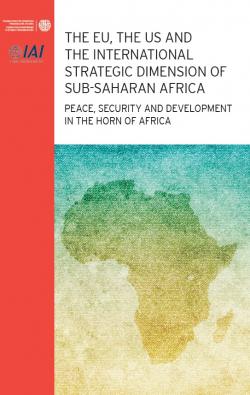The EU, the US and the International Strategic Dimension of Sub-Saharan Africa: Peace, Security and Development in the Horn of Africa
The strategic significance of Sub-Saharan Africa has increased considerably in recent decades, with various international actors establishing diversified yet increasingly important levels of engagement in the region. Countries such as Brazil, China, the Gulf states and Turkey have a significant presence in Africa, and some of them have well-established historical ties to the region as well. This edited publication – as the final result of a project on “The EU, the US and the International Strategic Dimension of Sub-Saharan Africa: Peace, Security and Development in the Horn of Africa” – aims at identifying the role of key external powers in promoting peace, security and development in Sub-Saharan Africa. The analysis pays attention to how African countries build their own capacities to deal with multiple partners and the new position in which they find themselves. In addition, a concrete and region-specific analysis is dedicated to the Horn of Africa and to Somalia in particular. The publication also provides recommendations for the external powers examined, with specific attention devoted to the European Union and the United States.
This book is the result of a project entitled “The EU, the US and the International Strategic Dimension of Sub-Saharan Africa: Peace, Security and Development in the Horn of Africa”.
Preface, by Ernst Stetter and Gianni Bonvicini, p. 9-11
Introduction, by Nicoletta Pirozzi and Bernardo Venturi, p. 13-17
1. Brazil as a Security and Development Provider in Africa: Consequences and Opportunities for Europe and North America, by Frank Mattheis, p. 19-40
1.1 Historical context
1.2 Relations after the Cold War
1.3 The role of Brazil in peace and security in Sub-Saharan Africa
1.4 The role of Brazil in development in Sub-Saharan Africa
1.5 Priorities and challenges of Brazil’s engagement in Sub-Saharan Africa
1.6 Recommendations for the EU and the US in the context of Brazil’s presence in Africa
2. China’s Relations with Sub-Saharan Africa, by Anna Katharina Stahl, p. 41-75
2.1 Introduction: China’s renewed diplomatic interest in Africa
2.2 China’s role as a development actor in SSA
2.2.1 Instruments and geographical coverage
2.2.2 Sectoral priorities
2.2.3 Guiding principles
2.2.4 China’s South-South cooperation with Africa
2.3 China’s growing contribution to African peace and security
2.4 Conclusion: The broader context of China’s engagement in SSA
2.4.1 China’s domestic priorities
2.4.2 Implications for the EU and the US
3. The Role of Gulf States in Peace and Security and Development in Sub-Saharan Africa, by Lidet Tadesse Shiferaw, p. 76-102
3.1 The role of the Gulf states in peace and security in SSA
3.1.1 The rise of the Gulf states as influential international and regional actors in SSA
3.1.2 The role of the Gulf states in peace and security in SSA
3.2 The role of the Gulf states in the economic development of SSA
3.2.1 GCC economic cooperation with SSA
3.2.2 GCC trade and investment in SSA
3.2.3 Main fields of impact and future prospects
3.2.4 Gulf investment controversies
3.3 Assessing main priorities and main challenges of the Gulf states
Recommendations
4. Turkey’s African Experience: From Venture to Normalization, by Mehmet Özkan, p. 103-123
4.1 Defining Turkey as an actor in Africa
4.2 The role of Turkey in peace and security in SSA
4.3 The role of Turkey in development in SSA
4.4 Priorities and challenges
Recommendations
5. The EU’s Struggle with Normative Leadership in Sub-Saharan Africa, by Bernardo Venturi, p. 124-151
5.1 EU engagement and relevance in the region
5.2 The role of the EU in peace and security issues in SSA
5.3 The role of the EU in development issues in SSA
5.4 The EU’s interaction with other international actors in SSA
5.4.1 The EU’s interaction with other international actors on peace and security
5.4.2 The EU’s interaction with other international actors on development cooperation
Conclusion: A comprehensive Africa policy for the EU
6. Security, Development, and Diplomacy: Solving the Puzzle of the US-Sub-Saharan Africa Strategy?, by Madeleine Goerg, p. 152-186
6.1 The evolution of the US’s engagement with SSA
6.2 The US as a peace and security actor in SSA
6.3 The US as a development actor in SSA
6.4 Recommendations for US and EU engagement with SSA
7. The Role of External Actors in Security and Development in the Horn of Africa: The Case of Somalia, by Rossella Marangio, p. 187-215
7.1 Security dynamics: Shifting towards holistic approaches
7.2 Development dynamics: The coordination game
Recommendations
8. Security and Development in Somalia: Attempts to Sustain Fragile Gains, by Cleophus Thomas III, p. 216-250
8.1 Security challenges
8.1.1 Lack of reliable and integrated security forces
8.1.2 Slow integration of security forces
8.1.2.1 ASWJ, Puntland, and Jubaland
8.2 Political and social reconciliation
8.2.1 AMISOM: Present and future
8.2.1.1 The future of AMISOM: A troubled transition?
8.3 Al-Shabaab and the jihadist threat
8.3.1 Mass raids
8.3.2 Civilian blockades
8.3.3 Future of al-Shabaab and regional implications
8.4 Trade, infrastructure, and food security
Conclusion and recommendations
Notes for Further Research, by Bernardo Venturi and Céline Guedes, p. 251-257
Contributors, p. 263-264
Abbreviations and Acronyms, p. 265-270



